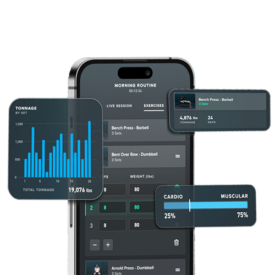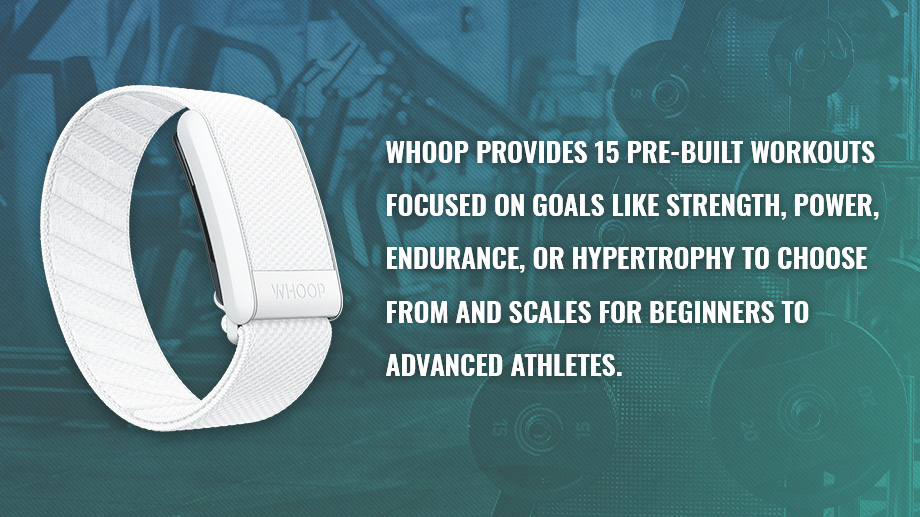The wearable technology company WHOOP has announced its latest feature — Strength Trainer — to improve consumers’ ability to measure their training progress. The WHOOP Strength Trainer is the “first wearable to comprehensively measure the impact strength training has on your body.” The feature tracks pretty much any metric an active gym-goer would want to know, including reps and quantifying muscular load based on weight usage.
Most wearables on the market only track cardiovascular strain, which isn’t typically sufficient for those who strength train. WHOOP acquired PUSH, a velocity-based training coaching solution, back in September 2021. PUSH’s algorithms have since been integrated into WHOOP’s hardware to track muscular load.

Take advantage of a free one-month trial of WHOOP, which includes full access to everything the app has to offer, along with a WHOOP 4.0 device.
How WHOOP Strength Trainer Works
The WHOOP Strength Trainer combines an accelerometer sensor for measuring acceleration and a gyroscope sensor with advanced biometrics to calculate the strain put on the musculoskeletal system. When worn on the wrist during training, WHOOP factors and tabulates those stresses into a more comprehensive “Strain” score, which includes cardiovascular and muscular load.
The WHOOP Strength Trainer tracks four distinct areas of measurement: muscular load, cardiovascular load, tonnage, and intensity. Here’s what each of those means:

- Muscular Load: Quantifies the cumulative exertion placed on muscles, bones, joints, and tissues based on the volume and intensity of training.
- Cardiovascular Load: Compares resting heart rate to max heart rate for an overall summary of the strain on the cardiovascular system.
- Tonnage: Measures the total effective volume lifted (i.e., the number of reps at each weight for each set for each exercise).
- Intensity: Measures how explosively each movement is performed.
WHOOP Strength Trainer’s ability to track unique movement profiles via biomechanics allows for more specific load measurements on the musculoskeletal system. It also provides further accuracy through a percentage bodyweight factor applied to the total weight.
The app’s library comprises nearly 200 of the most common strength training movements, so the WHOOP Strength Trainer should have no problems identifying which exercise its users perform in the gym. For those who are uncertain of which exercises or workouts to perform, WHOOP even provides 15 pre-built workouts focused on goals like power, endurance, or hypertrophy to choose from and scales for beginners to advanced athletes.
Research-Proven Benefits
For those who have never used a fitness wearable like the WHOOP Strength Trainer, it will likely help you become even more active. A 2020 meta-analysis in JMIR mHealth and uHealth found that wearable trackers may be associated with increases in physical activity. (1) Fitness wearables have since received further support for “increasing physical activity in a variety of age groups.” (2)

Take advantage of a free one-month trial of WHOOP, which includes full access to everything the app has to offer, along with a WHOOP 4.0 device.
Constantly Evolving
The more people who use the WHOOP Strength Trainer, the more intelligent the algorithms become and, therefore, the more accurate their measurements from workout to workout. Eventually, members will be able to share workouts with others and see their weight trends over time. WHOOP can add more exercises to their library based on feedback from their members and even incorporate a feature for custom exercises.

Thousands of hours of studying the impact of load from each exercise on the human body in WHOOP Labs has led to the pioneering of the WHOOP Strength Trainer. It is the first wearable to measure cardiovascular and muscular load and indicates WHOOP’s commitment to innovation in strength training.
References
- Tang, M. S. S., Moore, K., McGavigan, A., Clark, R. A., & Ganesan, A. N. (2020). Effectiveness of Wearable Trackers on Physical Activity in Healthy Adults: Systematic Review and Meta-Analysis of Randomized Controlled Trials. JMIR mHealth and uHealth, 8(7), e15576. https://doi.org/10.2196/15576
- Ferguson, T., Olds, T., Curtis, R., Blake, H., Crozier, A. J., Dankiw, K., Dumuid, D., Kasai, D., O’Connor, E., Virgara, R., & Maher, C. (2022). Effectiveness of wearable activity trackers to increase physical activity and improve health: a systematic review of systematic reviews and meta-analyses. The Lancet. Digital health, 4(8), e615–e626. https://doi.org/10.1016/S2589-7500(22)00111-X
Featured image: WHOOP